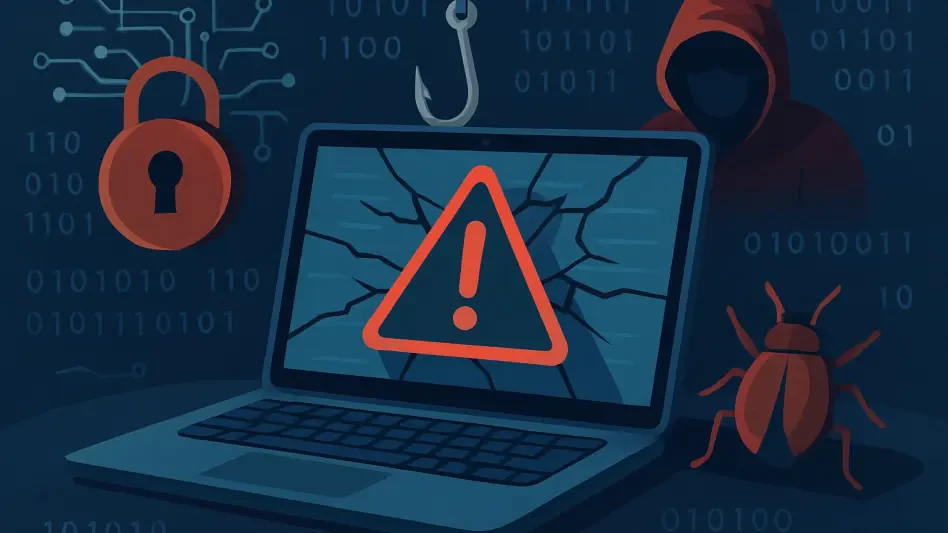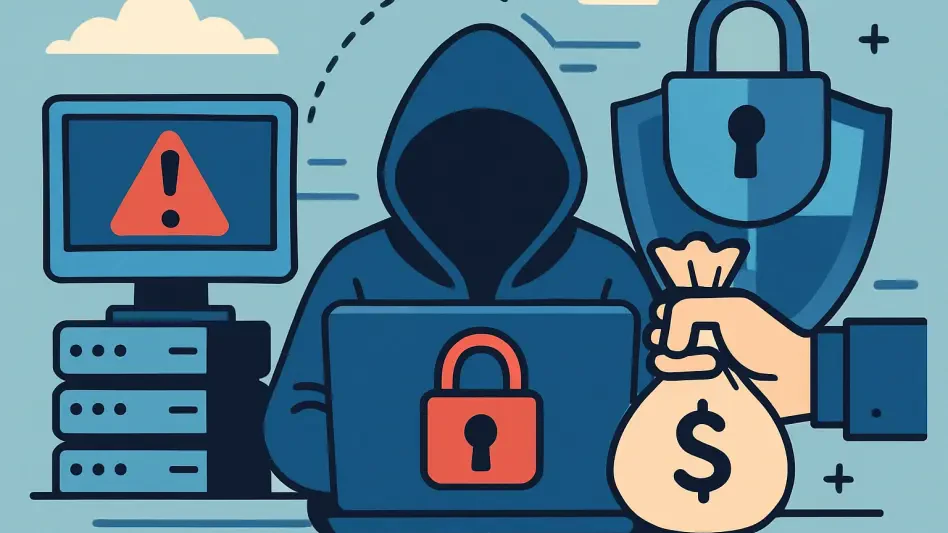In an era where digital systems underpin nearly every facet of modern life, the latest findings from Cyble Research & Intelligence Labs reveal a staggering cybersecurity crisis, with 717 new vulnerabilities identified in a single week from July 30 to August 5. This alarming figure, drawn from the weekly Threat Insights report, exposes the relentless pace at which cyber threats are evolving, challenging organizations and individuals to keep up with an ever-expanding attack surface. From critical flaws in widely used software to exploits circulating in underground forums, the data paints a sobering picture of the risks facing enterprise systems, connected devices, and personal data. As cybercriminals grow more sophisticated, leveraging everything from zero-day vulnerabilities to outdated technology, the urgency for proactive defense has never been clearer. This report not only highlights the sheer volume of threats but also underscores the narrowing window security teams have to respond before attackers strike. With digital transformation accelerating across industries, the stakes are higher than ever, making it imperative to understand the depth and breadth of these vulnerabilities. The insights provided by Cyble serve as a critical reminder that staying ahead of threats requires more than reactive measures—it demands vigilance, strategic planning, and real-time intelligence to safeguard digital ecosystems against a backdrop of persistent and complex cyber risks.
Unpacking the Surge of New Cybersecurity Flaws
The headline number from the Cyble report is nothing short of staggering: 717 new vulnerabilities emerged in just one week, posing immediate risks to systems worldwide. Of these, 114 are classified as critical under the CVSS v3.1 scoring system, with an additional 39 deemed critical under CVSS v4.0, signaling the potential for severe system compromise if left unaddressed. High-profile flaws affecting major vendors like Apple, Dell, and Microsoft stand out, with specific issues such as remote code execution vulnerabilities in Trend Micro Apex One posing threats of complete system takeover. These critical weaknesses could enable attackers to access sensitive data or disrupt operations on a massive scale. The sheer volume of these vulnerabilities, combined with their severity, places immense pressure on security teams to prioritize patching and mitigation efforts before exploitation occurs. This situation illustrates a broader challenge in cybersecurity—keeping pace with the rapid discovery of flaws across diverse platforms and applications.
Beyond the raw numbers, another troubling aspect emerges with 17 vulnerabilities tied to end-of-life (EOL) products from vendors such as Linksys, Netgear, and D-Link. These products, no longer supported with security updates, remain indefinitely vulnerable, serving as easy entry points for attackers. Organizations clinging to outdated technology face a persistent and unmitigated risk, as there are no patches to close these gaps. This issue points to a systemic problem in cybersecurity hygiene, where legacy systems, often critical to operations, become liabilities over time. Addressing this requires not just technical solutions but a cultural shift toward phasing out unsupported hardware and software, ensuring that digital infrastructure evolves alongside emerging threats.
Dark Web Dangers and Zero-Day Exploits
A particularly chilling finding from the Cyble analysis is the active trading of exploits in underground cybercrime forums, where five vulnerabilities were discussed and one zero-day flaw was disclosed during the reporting period. Zero-day vulnerabilities, which are unknown to vendors or the public until exploited, represent a critical blind spot for defenders. Notable examples include a Microsoft SharePoint zero-day and an exploit known as SMBGhost targeting Windows systems, both of which highlight the speed at which threat actors can weaponize flaws for malicious gain. This rapid circulation of exploit code in clandestine online communities drastically shortens the time organizations have to respond, often leaving systems exposed before patches are even available. The dark web’s role as a marketplace for such exploits amplifies the danger, turning technical flaws into commodities for profit or disruption.
This underground activity underscores a broader trend in cybercrime: the increasing organization and efficiency of malicious actors. The ability to quickly share and monetize exploits means that even newly discovered vulnerabilities can become widespread threats within hours or days. For enterprises, this reality necessitates a shift from traditional, reactive security models to more anticipatory strategies that leverage threat intelligence to identify risks before they are exploited. The presence of zero-day threats, in particular, emphasizes the importance of layered defenses and continuous monitoring to detect unusual activity that might indicate an attack in progress. As cybercriminals refine their tactics, staying informed about dark web trends becomes a critical component of any robust cybersecurity framework.
Expanding Attack Surfaces Across Platforms
Enterprise and open-source software continue to be prime targets for attackers, with trending exploits affecting widely deployed systems like SonicWall SMA 100 series appliances and components of Google Chrome such as ANGLE. These vulnerabilities, often discussed in both legitimate security circles and underground forums, expose a broad attack surface that spans industries and geographies. Meanwhile, Internet of Things (IoT) devices and Linux systems face relentless threats from malware families like Mirai and Gafgyt, which exploit unpatched flaws to orchestrate large-scale distributed denial-of-service (DDoS) attacks. The fragility of connected ecosystems, where devices often lack robust security controls, makes them attractive entry points for attackers seeking to compromise networks or disrupt services. This convergence of enterprise and IoT vulnerabilities illustrates the interconnected nature of modern digital threats.
Adding to this complexity, mobile platforms are increasingly under siege, with sophisticated malware campaigns targeting specific demographics, such as Bengali-speaking users, through deceptive remittance apps. These attacks steal banking credentials while covertly deploying cryptocurrency miners, blending data theft with resource exploitation. Such multi-stage threats demonstrate how attackers combine technical exploits with social engineering to bypass even well-designed defenses. The financial sector, in particular, faces heightened risks as mobile banking grows, making user education and endpoint security paramount. The expanding attack surface across enterprise, IoT, and mobile platforms signals a need for comprehensive security strategies that address both technical vulnerabilities and human factors, ensuring no aspect of the digital ecosystem is left unprotected.
Ongoing Malware and Phishing Challenges
The persistence of high-profile malware families like WannaCry ransomware and CoinMiner Linux remains a significant concern, as these threats continue to exploit system vulnerabilities to drain resources or infect devices. WannaCry, infamous for its global impact, still lingers in unpatched systems, while CoinMiner strains infrastructure by hijacking computing power for illicit gain. These malware strains often target IoT and Linux environments, where security measures may be less stringent, amplifying their destructive potential. Their enduring presence serves as a stark reminder that even older threats can remain relevant if systems are not updated or hardened against known exploits. This ongoing challenge highlights the importance of maintaining rigorous patch management and endpoint protection to neutralize such persistent dangers.
Phishing, too, continues to dominate as a primary attack vector, with over 52,900 new malicious email addresses identified as Indicators of Compromise (IoCs) during the reporting week. Attackers rely on impersonation, spoofing, and carefully crafted social engineering tactics to deceive users into divulging sensitive information or clicking on harmful links. Despite advancements in email filtering and user awareness programs, phishing remains effective due to its exploitation of human error—a factor that technology alone cannot fully mitigate. The sheer volume of these campaigns underscores the need for a multi-pronged approach, combining technical safeguards with ongoing training to equip users against deceptive tactics. As phishing evolves with more targeted and convincing methods, organizations must prioritize defenses that address both the technological and behavioral dimensions of this threat.
Harnessing Threat Intelligence for Defense
Amid a landscape of escalating cyber risks, Cyble’s Threat Hunting Service and Sensor Intelligence emerge as indispensable tools for real-time defense. By deploying honeypots and leveraging advanced analytics, Cyble captures critical data on exploit attempts, malware propagation, and phishing campaigns, translating these insights into actionable Indicators of Compromise (IoCs). This capability enables organizations to prioritize remediation efforts, focusing on the most imminent threats before they can be exploited. The value of such intelligence lies in its ability to provide early warnings, allowing security teams to shift from a reactive posture to one of proactive mitigation. In a world where attackers operate with alarming speed, having access to up-to-the-minute threat data can mean the difference between a contained incident and a full-scale breach.
The broader implications of Cyble’s approach point to a fundamental shift in cybersecurity strategy. Traditional methods, often centered on responding to breaches after they occur, are increasingly insufficient against the volume and sophistication of modern threats. Instead, continuous monitoring and risk-based vulnerability management offer a more effective path forward, enabling defenders to anticipate and neutralize risks in real time. Cyble’s role in delivering such insights through sensor networks and dark web monitoring highlights the growing importance of threat intelligence as a cornerstone of digital defense. For organizations grappling with an ever-expanding array of vulnerabilities, partnering with services that provide this level of visibility can significantly enhance resilience, ensuring that defenses evolve in tandem with the tactics of cybercriminals.
Strengthening Defenses Against Evolving Threats
Reflecting on the insights from the Cyble report for the week of July 30 to August 5, the cybersecurity landscape faced an unprecedented wave of challenges, with 717 new vulnerabilities underscoring the relentless pace of digital threats. Critical flaws in major vendors’ systems, active exploit trading in underground forums, and persistent risks to unsupported technology painted a complex picture of risk that demanded urgent attention. Malware like WannaCry and phishing campaigns with tens of thousands of malicious emails further compounded the dangers, exploiting both technical and human vulnerabilities with alarming success. The findings served as a powerful reminder of how interconnected and fragile digital ecosystems have become in the face of sophisticated cybercrime.
Looking ahead, the path to resilience lies in embracing proactive measures that address these multifaceted risks. Organizations must prioritize risk-based vulnerability management, ensuring that critical flaws are patched swiftly while phasing out end-of-life systems that can no longer be secured. Adopting Zero-Trust architectures can further limit the impact of breaches by enforcing strict access controls across networks. Additionally, investing in continuous monitoring and threat intelligence services offers a vital edge, providing real-time insights to stay ahead of emerging dangers. By combining these strategies with robust user education to counter phishing and social engineering, defenders can build a layered defense capable of withstanding the evolving tactics of attackers. The lessons from this report point to a future where anticipation, not reaction, becomes the foundation of cybersecurity.








